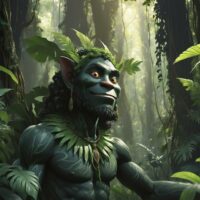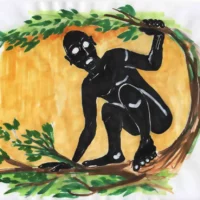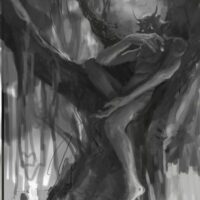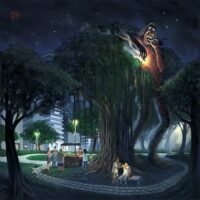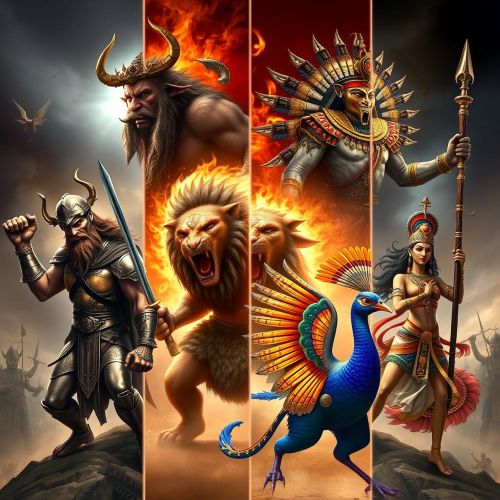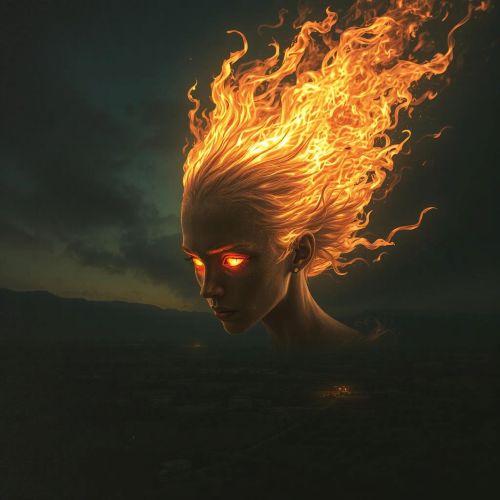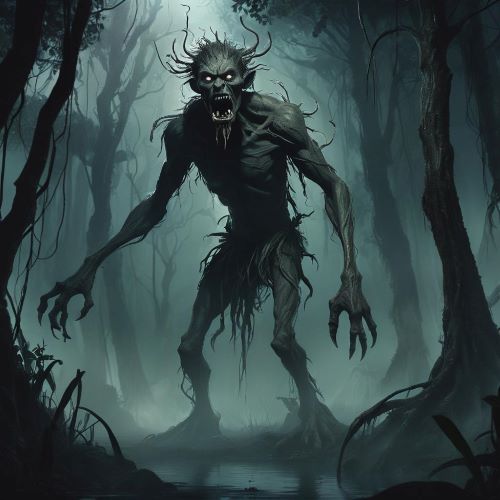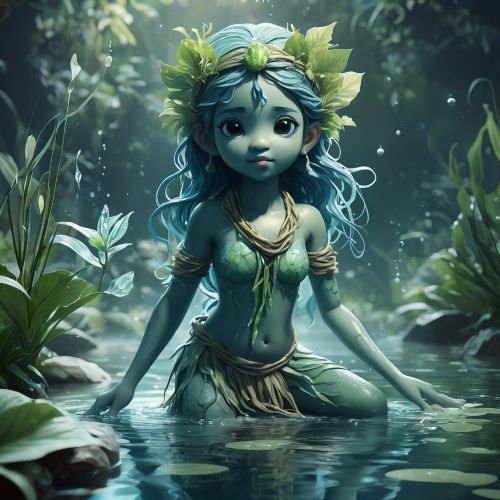Agta : The Forest Protector
Listen
At a glance
| Description | |
|---|---|
| Origin | Philippine Mythology |
| Classification | Spirits |
| Family Members | N/A |
| Region | Philippines |
| Associated With | Mischief, Protection, Pranks |
Agta
Introduction
The Agta, a captivating figure from Philippine mythology, is often depicted as a tree giant deeply embedded in the cultural traditions of the Philippines, notably in the Eastern Visayan provinces of Samar and Leyte. Their influence also extends to regions like Masbate and Bohol. The Agta’s legacy continues to captivate and intrigue, with stories handed down through generations. Within the archipelago’s rich tapestry of biodiversity and folklore, the Agta stands out as a mysterious and significant entity. Descriptions of the Agta vary across regions but consistently portray a large, enigmatic being with a complex relationship with humans.
Physical Traits
The Agta is typically portrayed as a towering figure with dark, sometimes charcoal-colored skin, emphasizing their immense size, often likened to giants dwelling within the forest canopy. Specific details about their facial features are limited, though they are described with a wild, untamed appearance. Habitat is integral to defining the Agta, as they are primarily associated with trees, inhabiting dense foliage or hollows within giant trunks. Some legends also mention them residing in cliffs or abandoned houses, highlighting their close connection to the untamed wilderness.
Described as mythical beings akin to humans but possessing unique physical traits, the Agta are often depicted as tall individuals with dark skin and unruly hair, indicative of their affinity for forest environments. Their eyes are believed to glimmer with an otherworldly light, capable of piercing through the darkest night. Renowned for their agility and swiftness, Agta move effortlessly through dense jungles and mountainous terrains, with legends suggesting their ability to seamlessly blend into their surroundings, becoming one with the natural world they inhabit.
Family
In Philippine mythology, the Agta are part of a family of supernatural creatures known to inhabit remote and secluded areas. They are often believed to be kin to other mythical beings like the Kapre (tree-dwelling giants) and Tikbalang (horse-headed tricksters). Despite their typically solitary nature, the Agta are thought to have complex familial relationships, occasionally depicted as protectors of specific territories or guardians of sacred places.
While details about the Agta’s social structure remain limited, certain regions associate them with the Kapre, another tree-dwelling creature in Philippine mythology. The Kapre is often described as a solitary entity, but the potential connection with the Agta suggests that Agta might exist within family groups or small communities.
In some contexts, the Agta is grouped with other tree-dwelling beings like the Kapre under the umbrella term of “tall, black, tree dwellers” in Philippine folklore. However, it’s important to note that the Agta is not merely a variety of Kapre but represents a distinct mythical entity within this broader classification.
Other names
The name of the Agta varies depending on the specific region within the Philippines, showing localized adaptations. In Eastern Visayas, particularly among the Waray people, the term “Agta” is commonly used. However, alternative names like “Tawo sa Lasang” (forest people) or “Tikbalang ng Bundok” (mountain tikbalang) are also mentioned in some sources, underscoring their close connection to the natural environment. In the Visayan dialect, the Agta is referred to as the “black one,” a name that reflects their dark complexion, a defining physical trait of this mythical figure. Furthermore, the Agta is sometimes linked with the Kapre, another mythical creature in Philippine folklore.
Across different regions of the Philippines, the Agta is known by various names. In some narratives, they are referred to as “Aeta” or “Agta ng Bundok,” highlighting their association with mountainous regions. In indigenous folklore, they are also called “Bal-Bal,” a term often used interchangeably to describe supernatural entities inhabiting the wilderness. These alternative names mirror the diverse cultural interpretations of the Agta and their significance within local beliefs.
Powers and Abilities
The Agta’s impressive abilities underscore their status as formidable inhabitants of the wilderness. Their colossal size grants them extraordinary strength, enabling them to manipulate trees and pose a potential threat to humans who disrespect their territory. In certain accounts, the Agta are depicted as nature protectors, particularly of the sea. These benevolent Agta may warn fishermen about approaching storms or hazardous currents, even resorting to physical actions like pushing trees into the water to discourage them from venturing out.
However, not all narratives paint the Agta in a positive light. In some regions, they are regarded as mischievous tricksters who delight in playing pranks on unsuspecting humans. These pranks range from innocently hiding tools or utensils to more unsettling acts of deception. The Agta’s close affinity with the wilderness suggests a possible connection to natural phenomena. Legends from certain areas hint at their ability to manipulate the wind or influence the growth of vegetation.
Additionally, the Agta is revered as a forest protector, believed to communicate with other creatures and possess the ability to heal the sick. Despite their imposing physical presence, the Agta is often described as a gentle spirit that observes and watches from their dwellings without causing harm to humans.
Central to the mythos of the Agta are their extraordinary powers and abilities. They are believed to possess unparalleled strength, capable of outwitting and overpowering any human who dares to trespass into their domain. Agta are often associated with elemental control, commanding the forces of nature such as rain, thunder, and fire. They are said to possess healing abilities, utilizing the potent flora of the forest to treat ailments and injuries. Furthermore, Agta are portrayed as shapeshifters, assuming various forms to navigate the mystical realms they inhabit.
Modern Day Influence
The Agta holds a significant place in Philippine culture and history, with its stories used to elucidate natural phenomena like rustling leaves and tree movements. This mythical figure also embodies respect for the natural world, emphasizing the importance of environmental stewardship in contemporary society.
In Filipino folklore and popular culture, the Agta remains prominent, serving as cautionary tales that underscore the need to honor nature’s power. Stories of their playful pranks explain the sudden disappearance of everyday objects, injecting whimsy into daily life. Contemporary art frequently incorporates the Agta’s image, depicting them as towering figures, sometimes emphasizing their affinity with nature—portrayals can range from benevolent guardians to mischievous tricksters.
Rooted in ancient folklore, the legacy of the Agta continues to resonate in modern Philippine culture. Their image is immortalized in literature, art, and media, symbolizing the country’s deep connection with its natural heritage. Contemporary storytellers draw inspiration from the Agta, weaving narratives that explore themes of wilderness, conservation, and the supernatural. The portrayal of Agta in popular culture ensures their enduring presence in the collective consciousness of Filipinos, enriching the ongoing tapestry of Philippine mythology.
Related Images
Frequently Asked Questions
What is lorem Ipsum?
I am text block. Click edit button to change this text. Lorem ipsum dolor sit amet, consectetur adipiscing elit. Ut elit tellus, luctus nec ullamcorper mattis, pulvinar dapibus leo.
What is lorem Ipsum?
I am text block. Click edit button to change this text. Lorem ipsum dolor sit amet, consectetur adipiscing elit. Ut elit tellus, luctus nec ullamcorper mattis, pulvinar dapibus leo.
What is lorem Ipsum?
I am text block. Click edit button to change this text. Lorem ipsum dolor sit amet, consectetur adipiscing elit. Ut elit tellus, luctus nec ullamcorper mattis, pulvinar dapibus leo.
What is lorem Ipsum?
I am text block. Click edit button to change this text. Lorem ipsum dolor sit amet, consectetur adipiscing elit. Ut elit tellus, luctus nec ullamcorper mattis, pulvinar dapibus leo.
What is lorem Ipsum?
I am text block. Click edit button to change this text. Lorem ipsum dolor sit amet, consectetur adipiscing elit. Ut elit tellus, luctus nec ullamcorper mattis, pulvinar dapibus leo.

